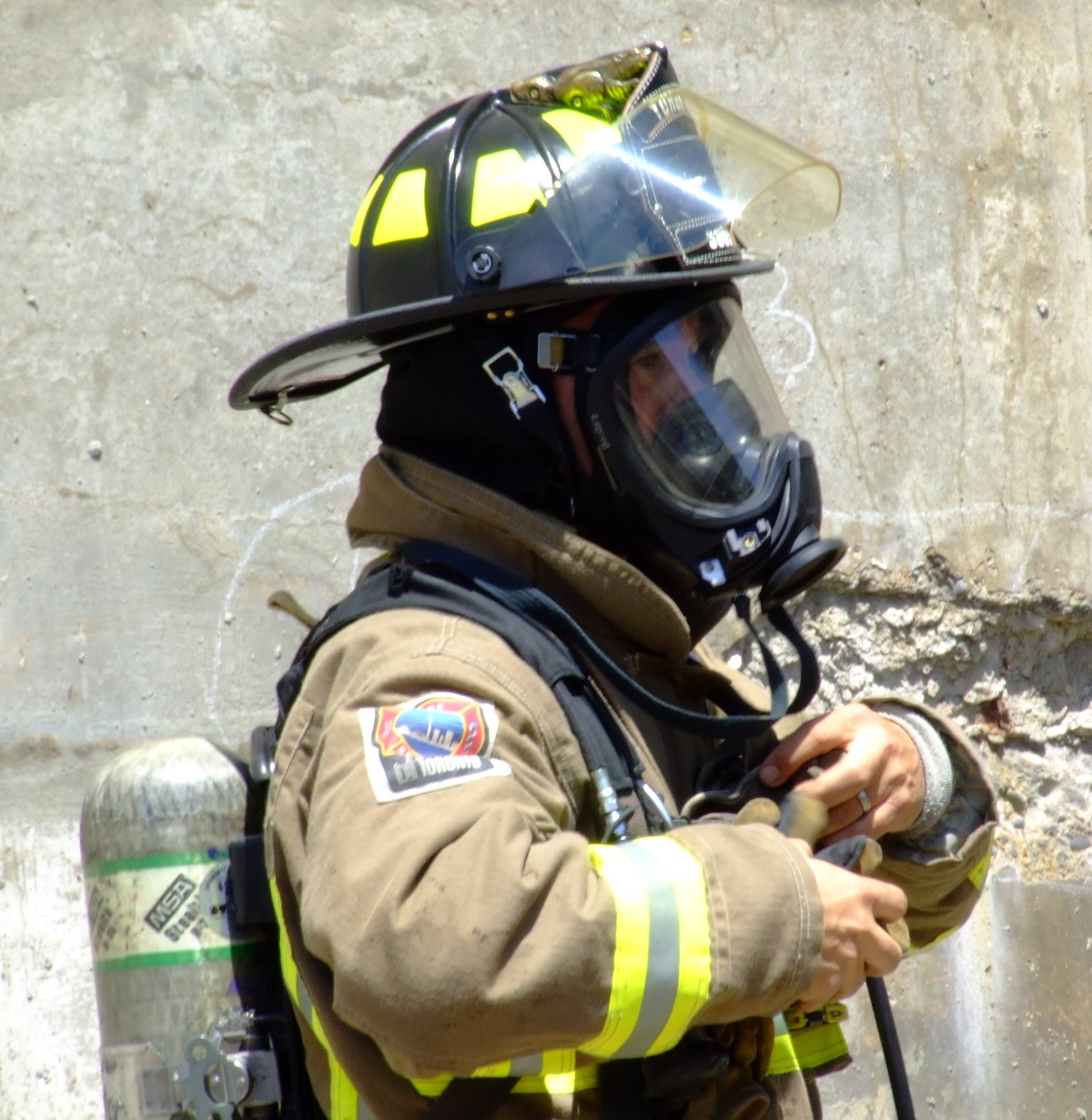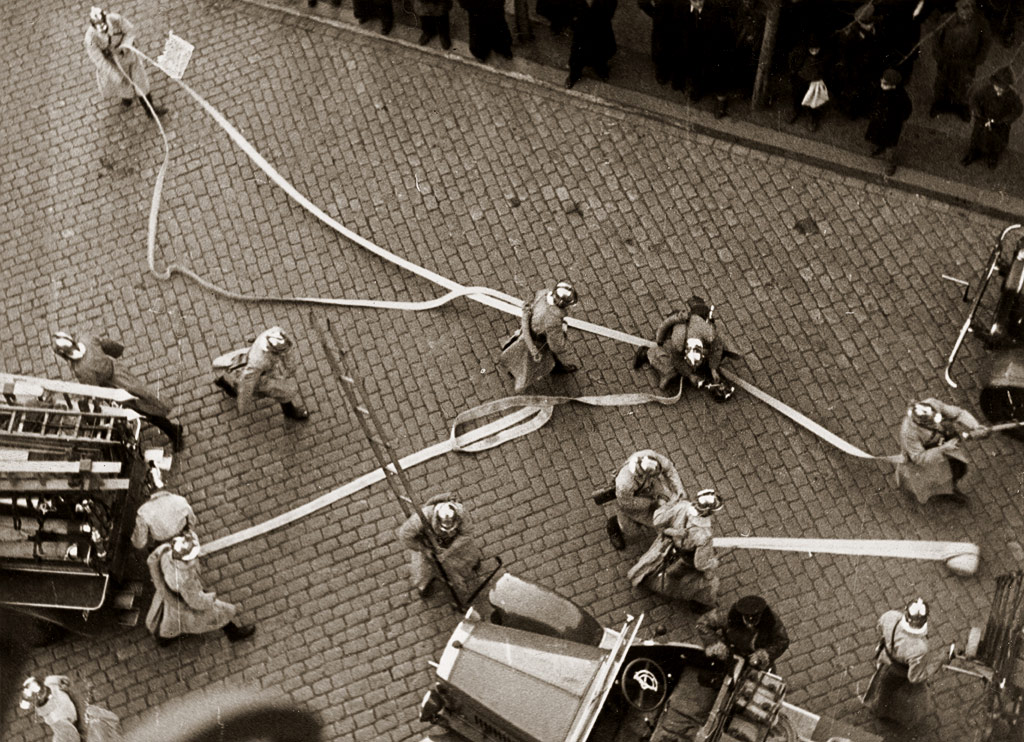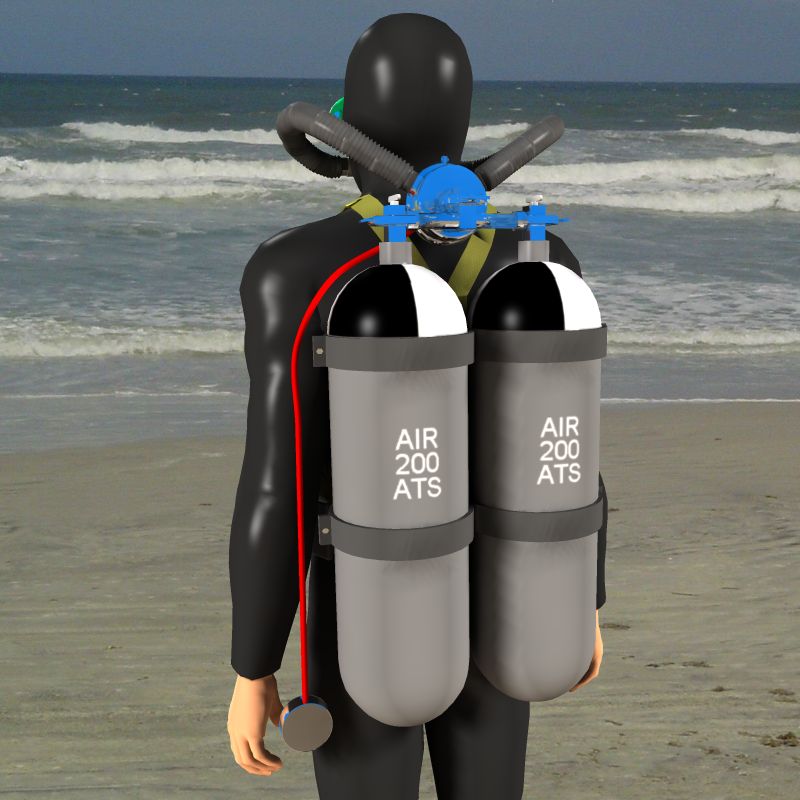|
Siebe Gorman Proto
The Proto is a type of rebreather that was made by Siebe Gorman. It was an industrial breathing set and not suitable for diving. It was made from 1914 or earlier to the 1960s or later. (Distinguish from "Proton", which is another sort of Siebe Gorman rebreather). Also known as proto suits. Its breathing bag was worn on the chest. It had one or two oxygen cylinders, across the lumbar part of the back: often one, buthis imageshows two. Its duration in use was one or two hours, dependent on the size of oxygen cylinder fitted. Its absorbent (tradename Protosorb) was loose in the bottom of the breathing bag, restrained by a perforated cloth partition, and not in a canister. It had two wide breathing tubes running from the breathing bag to either a strapped-in mouthpiece (used with goggles) or an industrial-type fullface mask known as a Vistarama face mask, with a curved window and an inner orinasal mask. The canister seen on the front of the bag was to cool the gas in circuit, as the ... [...More Info...] [...Related Items...] OR: [Wikipedia] [Google] [Baidu] |
Rebreather
A rebreather is a breathing apparatus that absorbs the carbon dioxide of a user's breathing, exhaled breath to permit the rebreathing (recycling) of the substantially unused oxygen content, and unused inert content when present, of each breath. Oxygen is added to replenish the amount metabolised by the user. This differs from open-circuit breathing apparatus, where the exhaled gas is discharged directly into the environment. The purpose is to extend the breathing endurance of a limited gas supply, and, for covert military use by frogmen or observation of underwater life, eliminating the bubbles produced by an open circuit system and in turn not scaring wildlife being filmed. A rebreather is generally understood to be a portable unit carried by the user. The same technology on a vehicle or non-mobile installation is more likely to be referred to as a life-support system. Rebreather technology may be used where breathing gas supply is limited, such as underwater or in space, where ... [...More Info...] [...Related Items...] OR: [Wikipedia] [Google] [Baidu] |
Firefighter
A firefighter is a first responder and rescuer extensively trained in firefighting, primarily to extinguish hazardous fires that threaten life, property, and the environment as well as to rescue people and in some cases or jurisdictions also animals from dangerous situations. Male firefighters are sometimes referred to as firemen (and, less commonly, a female firefighter as firewoman). The fire service, also known in some countries as the fire brigade or fire department, is one of the three main emergency services. From urban areas to aboard ships, firefighters have become ubiquitous around the world. The skills required for safe operations are regularly practised during training evaluations throughout a firefighter's career. Initial firefighting skills are normally taught through local, regional or state-approved fire academies or training courses. Depending on the requirements of a department, additional skills and certifications such as technical rescue and pre-hospital ... [...More Info...] [...Related Items...] OR: [Wikipedia] [Google] [Baidu] |
Industrial Breathing Sets
A self-contained breathing apparatus (SCBA), sometimes referred to as a compressed air breathing apparatus (CABA) or simply breathing apparatus (BA), is a device worn to provide breathable air in an atmosphere that is immediately dangerous to life or health. They are typically used in firefighting and industry. The term ''self-contained'' means that the SCBA is not dependent on a remote supply of breathing gas (e.g., through a long hose). If designed for use under water, it is also known as a Scuba set (self-contained underwater breathing apparatus). When not used underwater, they are sometimes called industrial breathing sets. Unofficial names include ''air pack'', ''air tank'', ''oxygen cylinder'' or simply ''pack'', which are mostly used in firefighting. An SCBA typically has three main components: a high-pressure tank (e.g., , about 150 to 374 atmospheres), a pressure regulator, and an inhalation connection (mouthpiece, mouth mask or face mask), connected together and mount ... [...More Info...] [...Related Items...] OR: [Wikipedia] [Google] [Baidu] |
Firefighting Equipment
Firefighting is the act of extinguishing or preventing the spread of unwanted fires from threatening human lives and destroying property and the environment. A person who engages in firefighting is known as a firefighter. Firefighters typically undergo a high degree of technical training. This involves structural firefighting and wildland firefighting. Specialized training includes aircraft firefighting, shipboard firefighting, aerial firefighting, maritime firefighting, and proximity firefighting. Firefighting is a dangerous profession due to the toxic environment created by combustible materials, with major risks are smoke, oxygen deficiency, elevated temperatures, poisonous atmospheres, and violent air flows. To combat some of these risks, firefighters carry self-contained breathing apparatus. Additional hazards include falls — a constant peril while navigating unfamiliar layouts or confined spaces amid shifting debris under limited visibility – and structural collapse t ... [...More Info...] [...Related Items...] OR: [Wikipedia] [Google] [Baidu] |
Rebreathers
A rebreather is a breathing apparatus that absorbs the carbon dioxide of a user's exhaled breath to permit the rebreathing (recycling) of the substantially unused oxygen content, and unused inert content when present, of each breath. Oxygen is added to replenish the amount metabolised by the user. This differs from open-circuit breathing apparatus, where the exhaled gas is discharged directly into the environment. The purpose is to extend the breathing endurance of a limited gas supply, and, for covert military use by frogmen or observation of underwater life, eliminating the bubbles produced by an open circuit system and in turn not scaring wildlife being filmed. A rebreather is generally understood to be a portable unit carried by the user. The same technology on a vehicle or non-mobile installation is more likely to be referred to as a life-support system. Rebreather technology may be used where breathing gas supply is limited, such as underwater or in space, where the envir ... [...More Info...] [...Related Items...] OR: [Wikipedia] [Google] [Baidu] |
RANSUM
The Royal Australian Navy School of Underwater Medicine (RANSUM) is an instructor-led training course based at Sydney, Australia. History Before 1961 medical support at the diving section of HMAS ''Watson'' was provided by the District Medical Officer, Surgeon Lieutenant Commander Shane A.C. Watson, whose interest in diving led to research in injuries related to marine animals. Medical Director-General of the Royal Australian Navy, Surgeon Rear Admiral Lionel Lockwood, recognized the need for a specialisation in diving medicine and appointed Surgeon Lieutenant Commander Rex Gray to service in Underwater Medicine. Dr. Gray was an anaesthesiologist and accepted this commission on 20 February 1961. Dr. Gray was trained as a diver and sent to England for seven months to learn about modern diving medicine. He visited the Royal Naval Medical School at Alverstoke, the R.N. Physiological Laboratory, the Submarine Training School at HMS Dolphin, Diving School HMS ''Vernon'', and th ... [...More Info...] [...Related Items...] OR: [Wikipedia] [Google] [Baidu] |
Fleuss
Henry Albert Fleuss (13 June 1851 – 6 January 1933) was a pioneering diving engineer, and Master Diver for Siebe, Gorman & Co. of London. Fleuss was born in Marlborough, Wiltshire in 1851. In 1878 he was granted a patent which improved rebreathers. His apparatus consisted of a rubber mask connected to a breathing bag, with (estimated) 50-60% O2 supplied from a copper tank and CO2 scrubbed by rope yarn soaked in a solution of caustic potash, the system giving a duration of about three hours. Fleuss tested his device in 1879 by spending an hour submerged in a water tank, then one week later by diving to a depth of 5.5m in open water, upon which occasion he was slightly injured when his assistants abruptly pulled him to the surface. Fleuss's apparatus was first used under operational conditions in November 1880 by Alexander Lambert, lead diver of the Severn Tunnel construction project. Trained by Fleuss, he was able to close a submerged sluice door in the tunnel which had defe ... [...More Info...] [...Related Items...] OR: [Wikipedia] [Google] [Baidu] |
Smithfield Central Meat Market
Smithfield, properly known as West Smithfield, is a district located in Central London, part of Farringdon Without, the most westerly ward of the City of London, England. Smithfield is home to a number of City institutions, such as St Bartholomew's Hospital and livery halls, including those of the Butchers' and Haberdashers' Companies. The area is best known for the Smithfield meat market, which dates from the 10th century, has been in continuous operation since medieval times, and is now London's only remaining wholesale market. Smithfield's principal street is called ''West Smithfield'', and the area also contains London's oldest surviving church, St Bartholomew-the-Great, founded in AD 1123. The area has borne witness to many executions of heretics and political rebels over the centuries, as well as Scottish knight Sir William Wallace, and Wat Tyler, leader of the Peasants' Revolt, among many other religious reformers and dissenters. Smithfield Market, a Grade I ... [...More Info...] [...Related Items...] OR: [Wikipedia] [Google] [Baidu] |
Howe Bridge Mines Rescue Station
Howe Bridge Mines Rescue Station was the first mines rescue station on the Lancashire Coalfield opened in 1908 in Howe Bridge, Atherton, then in the historic county of Lancashire, England. Before Britain's first mines rescue station opened at Tankersley in Yorkshire in 1902, pit managers and volunteers were usually the first untrained mines rescuers. They fought fires, rescued victims and recovered bodies in the collieries in which they worked. Rescue stations were recommended in a Royal Commission in 1886 but were not compulsory until after the 1911 Coal Mines Act was passed. In 1906 the Lancashire and Cheshire Coal Owners Association formed a committee which decided to provide a mines rescue station in Lovers Lane Atherton. The first rescuers were provided with Siebe Gorman Proto breathing apparatus which was selected by competition. A team from the rescue station was tasked with training rescue teams from each colliery, and provided emergency assistance to collieries throu ... [...More Info...] [...Related Items...] OR: [Wikipedia] [Google] [Baidu] |
Rescue
Rescue comprises responsive operations that usually involve the saving of life, or the urgent treatment of injuries after an accident or a dangerous situation. Tools used might include search and rescue dogs, mounted search and rescue horses, helicopters, the "jaws of life", and other hydraulic cutting and spreading tools used to extricate individuals from wrecked vehicles. Rescue operations are sometimes supported by rescue vehicles operated by rescue squads. Rescue is a potent theme in human psychology, both from mortal perils and moral perils, and is often treated in fiction, with the rescue of a damsel in distress being a notable trope. Psychoanalyst Sigmund Freud introduced the concept of "rescue fantasies" by men pursuing "fallen women" in his 1910 work "A Special Type of Choice of Object Made by Men"; Freud's insight into this aspect of male psychology might retain merit, though his proposed Oedipus complex used to frame this concept is no longer in vogue. Withi ... [...More Info...] [...Related Items...] OR: [Wikipedia] [Google] [Baidu] |
Aqua-lung
Aqua-Lung was the first open-circuit, self-contained underwater breathing apparatus (or "scuba") to achieve worldwide popularity and commercial success. This class of equipment is now commonly referred to as a twin-hose diving regulator, or demand valve. The Aqua-Lung was invented in France during the winter of 1942–1943 by two Frenchmen: the engineer Émile Gagnan and the Naval Lieutenant (French: "lieutenant de vaisseau") Jacques Cousteau. It allowed Cousteau and Gagnan to film and explore underwater more easily. The invention revolutionised autonomous underwater diving by providing a compact, reliable system capable of a greater depth range and endurance than its precursors, and was a major factor influencing the development of recreational scuba diving after WWII. The twin-hose Aqua-Lung demand regulator is the foundation of all modern scuba regulators. A diaphragm is used to control a valve to deliver the breathing gas to the diver on demand, at ambient water pressure. Ho ... [...More Info...] [...Related Items...] OR: [Wikipedia] [Google] [Baidu] |
SCBA
A self-contained breathing apparatus (SCBA), sometimes referred to as a compressed air breathing apparatus (CABA) or simply breathing apparatus (BA), is a device worn to provide breathable air in an atmosphere that is immediately dangerous to life or health. They are typically used in firefighting and industry. The term ''self-contained'' means that the SCBA is not dependent on a remote supply of breathing gas (e.g., through a long hose). If designed for use under water, it is also known as a Scuba set (self-contained underwater breathing apparatus). When not used underwater, they are sometimes called industrial breathing sets. Unofficial names include ''air pack'', ''air tank'', ''oxygen cylinder'' or simply ''pack'', which are mostly used in firefighting. An SCBA typically has three main components: a high-pressure tank (e.g., , about 150 to 374 atmospheres), a pressure regulator, and an inhalation connection (mouthpiece, mouth mask or face mask), connected together and mount ... [...More Info...] [...Related Items...] OR: [Wikipedia] [Google] [Baidu] |







